Theories of Governance, Stewardship, and Leadership Effectiveness
VerifiedAdded on 2023/01/19
|13
|4028
|75
Essay
AI Summary
This essay provides a comprehensive overview of seminal theories of governance and stewardship that inform effective organizational leadership, focusing on both non-profit and for-profit organizations. The paper begins with an introduction highlighting the importance of governance and ethical leadership in the contemporary business environment. It then delves into a discussion of key governance theories, including organizational, cultural, and structural-functional theories, analyzing their contributions to organizational effectiveness. The essay further explores the application of stewardship theory, examining how it promotes effective governance by emphasizing the responsibility of leaders as stewards of stakeholder wealth and interests. The role of a leader’s values and beliefs in ensuring effective governance is discussed, underscoring the importance of ethical leadership. Drawing on a minimum of ten scholarly sources, the essay utilizes APA 6 format and incorporates biblical/ethical principles to support its assertions, culminating in a conclusion that summarizes the key findings and their implications for organizational leadership.
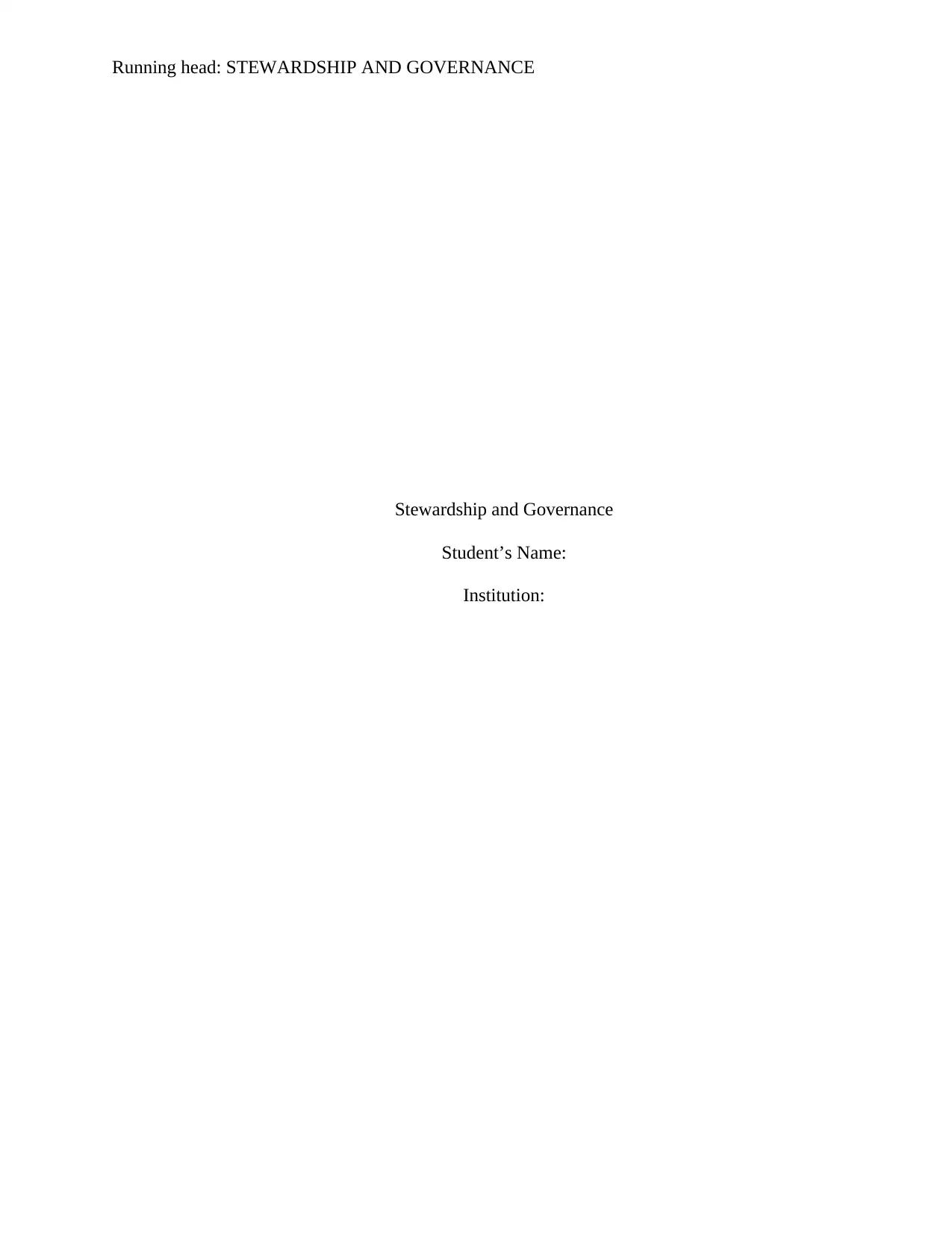
Running head: STEWARDSHIP AND GOVERNANCE
Stewardship and Governance
Student’s Name:
Institution:
Stewardship and Governance
Student’s Name:
Institution:
Paraphrase This Document
Need a fresh take? Get an instant paraphrase of this document with our AI Paraphraser
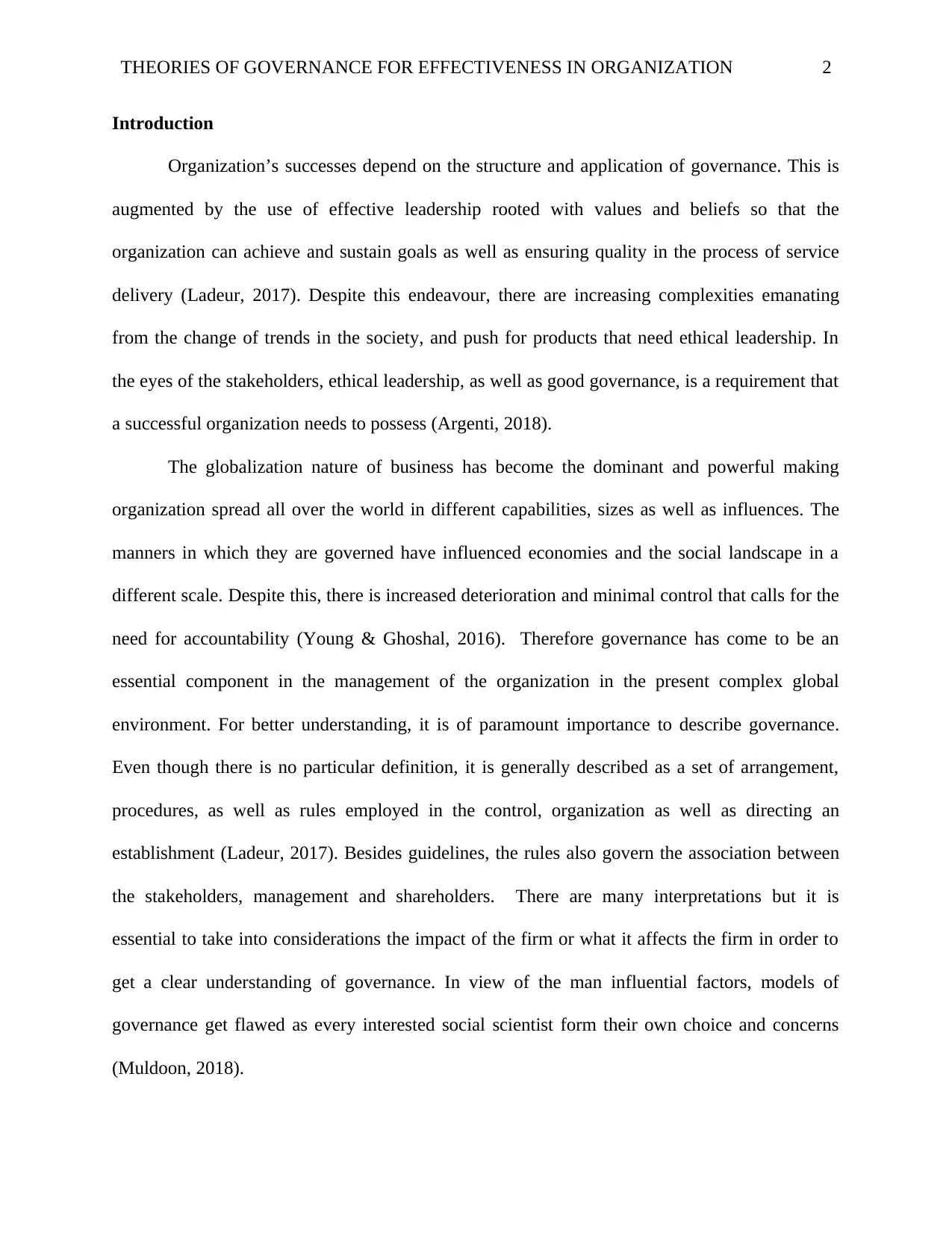
THEORIES OF GOVERNANCE FOR EFFECTIVENESS IN ORGANIZATION 2
Introduction
Organization’s successes depend on the structure and application of governance. This is
augmented by the use of effective leadership rooted with values and beliefs so that the
organization can achieve and sustain goals as well as ensuring quality in the process of service
delivery (Ladeur, 2017). Despite this endeavour, there are increasing complexities emanating
from the change of trends in the society, and push for products that need ethical leadership. In
the eyes of the stakeholders, ethical leadership, as well as good governance, is a requirement that
a successful organization needs to possess (Argenti, 2018).
The globalization nature of business has become the dominant and powerful making
organization spread all over the world in different capabilities, sizes as well as influences. The
manners in which they are governed have influenced economies and the social landscape in a
different scale. Despite this, there is increased deterioration and minimal control that calls for the
need for accountability (Young & Ghoshal, 2016). Therefore governance has come to be an
essential component in the management of the organization in the present complex global
environment. For better understanding, it is of paramount importance to describe governance.
Even though there is no particular definition, it is generally described as a set of arrangement,
procedures, as well as rules employed in the control, organization as well as directing an
establishment (Ladeur, 2017). Besides guidelines, the rules also govern the association between
the stakeholders, management and shareholders. There are many interpretations but it is
essential to take into considerations the impact of the firm or what it affects the firm in order to
get a clear understanding of governance. In view of the man influential factors, models of
governance get flawed as every interested social scientist form their own choice and concerns
(Muldoon, 2018).
Introduction
Organization’s successes depend on the structure and application of governance. This is
augmented by the use of effective leadership rooted with values and beliefs so that the
organization can achieve and sustain goals as well as ensuring quality in the process of service
delivery (Ladeur, 2017). Despite this endeavour, there are increasing complexities emanating
from the change of trends in the society, and push for products that need ethical leadership. In
the eyes of the stakeholders, ethical leadership, as well as good governance, is a requirement that
a successful organization needs to possess (Argenti, 2018).
The globalization nature of business has become the dominant and powerful making
organization spread all over the world in different capabilities, sizes as well as influences. The
manners in which they are governed have influenced economies and the social landscape in a
different scale. Despite this, there is increased deterioration and minimal control that calls for the
need for accountability (Young & Ghoshal, 2016). Therefore governance has come to be an
essential component in the management of the organization in the present complex global
environment. For better understanding, it is of paramount importance to describe governance.
Even though there is no particular definition, it is generally described as a set of arrangement,
procedures, as well as rules employed in the control, organization as well as directing an
establishment (Ladeur, 2017). Besides guidelines, the rules also govern the association between
the stakeholders, management and shareholders. There are many interpretations but it is
essential to take into considerations the impact of the firm or what it affects the firm in order to
get a clear understanding of governance. In view of the man influential factors, models of
governance get flawed as every interested social scientist form their own choice and concerns
(Muldoon, 2018).
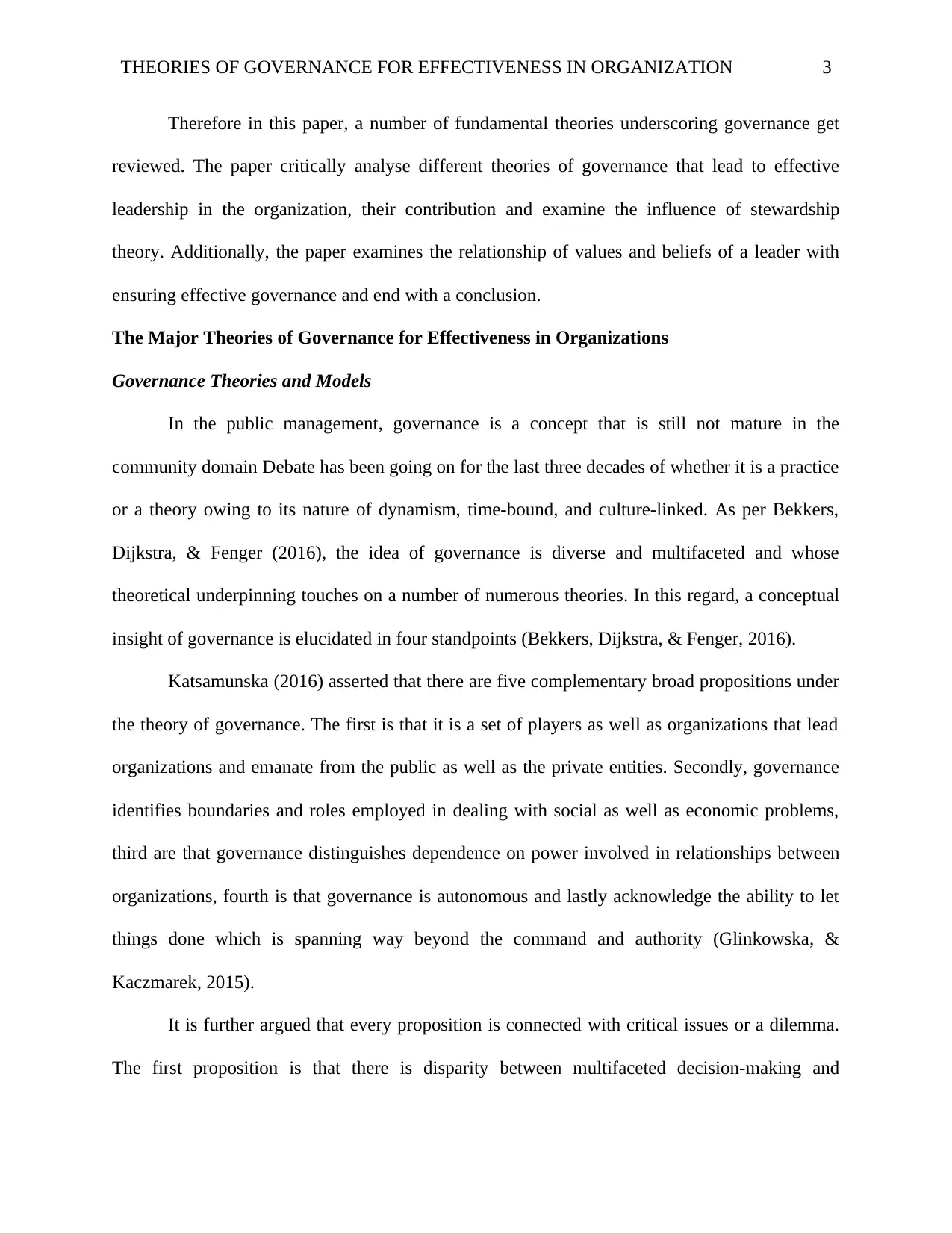
THEORIES OF GOVERNANCE FOR EFFECTIVENESS IN ORGANIZATION 3
Therefore in this paper, a number of fundamental theories underscoring governance get
reviewed. The paper critically analyse different theories of governance that lead to effective
leadership in the organization, their contribution and examine the influence of stewardship
theory. Additionally, the paper examines the relationship of values and beliefs of a leader with
ensuring effective governance and end with a conclusion.
The Major Theories of Governance for Effectiveness in Organizations
Governance Theories and Models
In the public management, governance is a concept that is still not mature in the
community domain Debate has been going on for the last three decades of whether it is a practice
or a theory owing to its nature of dynamism, time-bound, and culture-linked. As per Bekkers,
Dijkstra, & Fenger (2016), the idea of governance is diverse and multifaceted and whose
theoretical underpinning touches on a number of numerous theories. In this regard, a conceptual
insight of governance is elucidated in four standpoints (Bekkers, Dijkstra, & Fenger, 2016).
Katsamunska (2016) asserted that there are five complementary broad propositions under
the theory of governance. The first is that it is a set of players as well as organizations that lead
organizations and emanate from the public as well as the private entities. Secondly, governance
identifies boundaries and roles employed in dealing with social as well as economic problems,
third are that governance distinguishes dependence on power involved in relationships between
organizations, fourth is that governance is autonomous and lastly acknowledge the ability to let
things done which is spanning way beyond the command and authority (Glinkowska, &
Kaczmarek, 2015).
It is further argued that every proposition is connected with critical issues or a dilemma.
The first proposition is that there is disparity between multifaceted decision-making and
Therefore in this paper, a number of fundamental theories underscoring governance get
reviewed. The paper critically analyse different theories of governance that lead to effective
leadership in the organization, their contribution and examine the influence of stewardship
theory. Additionally, the paper examines the relationship of values and beliefs of a leader with
ensuring effective governance and end with a conclusion.
The Major Theories of Governance for Effectiveness in Organizations
Governance Theories and Models
In the public management, governance is a concept that is still not mature in the
community domain Debate has been going on for the last three decades of whether it is a practice
or a theory owing to its nature of dynamism, time-bound, and culture-linked. As per Bekkers,
Dijkstra, & Fenger (2016), the idea of governance is diverse and multifaceted and whose
theoretical underpinning touches on a number of numerous theories. In this regard, a conceptual
insight of governance is elucidated in four standpoints (Bekkers, Dijkstra, & Fenger, 2016).
Katsamunska (2016) asserted that there are five complementary broad propositions under
the theory of governance. The first is that it is a set of players as well as organizations that lead
organizations and emanate from the public as well as the private entities. Secondly, governance
identifies boundaries and roles employed in dealing with social as well as economic problems,
third are that governance distinguishes dependence on power involved in relationships between
organizations, fourth is that governance is autonomous and lastly acknowledge the ability to let
things done which is spanning way beyond the command and authority (Glinkowska, &
Kaczmarek, 2015).
It is further argued that every proposition is connected with critical issues or a dilemma.
The first proposition is that there is disparity between multifaceted decision-making and
⊘ This is a preview!⊘
Do you want full access?
Subscribe today to unlock all pages.

Trusted by 1+ million students worldwide
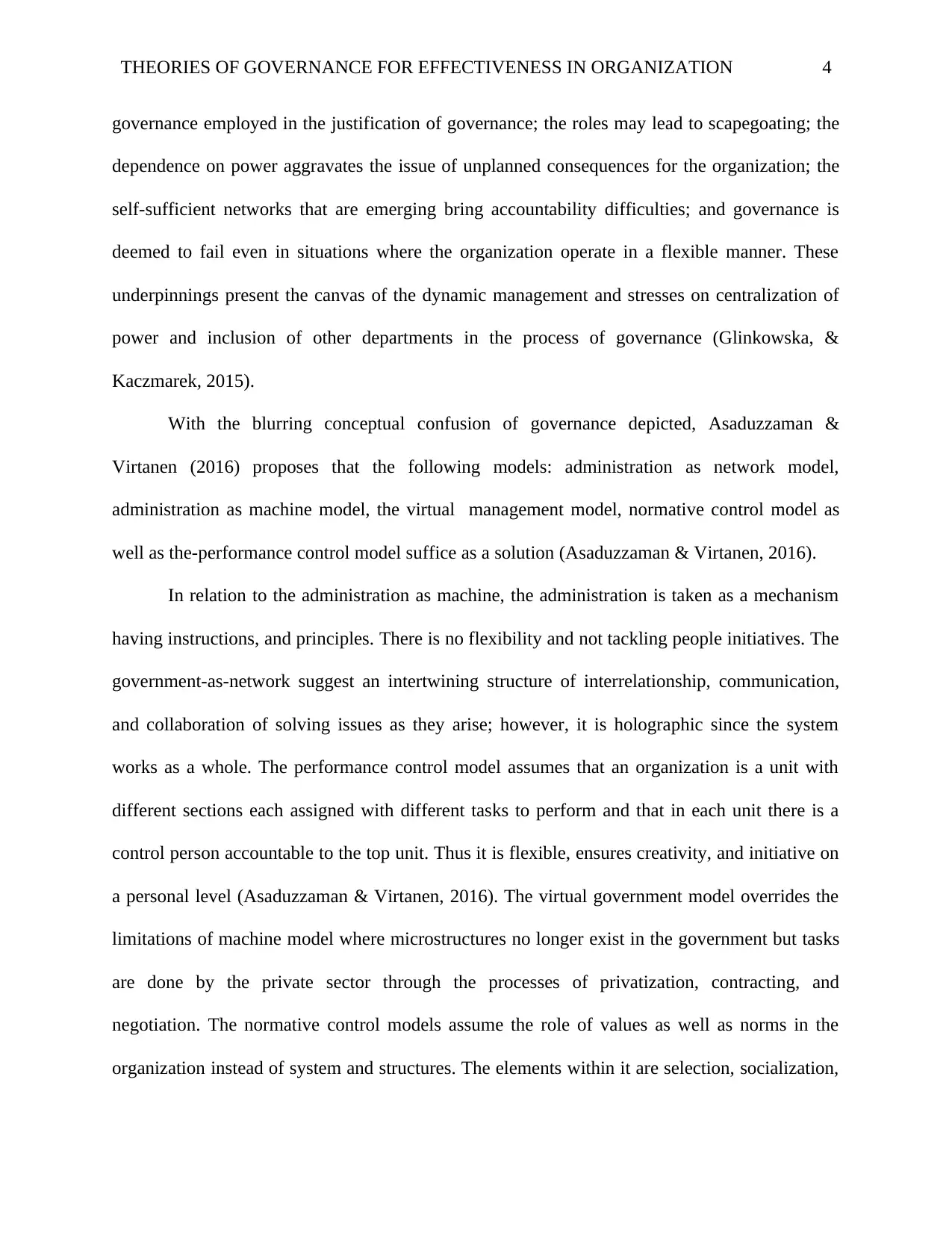
THEORIES OF GOVERNANCE FOR EFFECTIVENESS IN ORGANIZATION 4
governance employed in the justification of governance; the roles may lead to scapegoating; the
dependence on power aggravates the issue of unplanned consequences for the organization; the
self-sufficient networks that are emerging bring accountability difficulties; and governance is
deemed to fail even in situations where the organization operate in a flexible manner. These
underpinnings present the canvas of the dynamic management and stresses on centralization of
power and inclusion of other departments in the process of governance (Glinkowska, &
Kaczmarek, 2015).
With the blurring conceptual confusion of governance depicted, Asaduzzaman &
Virtanen (2016) proposes that the following models: administration as network model,
administration as machine model, the virtual management model, normative control model as
well as the-performance control model suffice as a solution (Asaduzzaman & Virtanen, 2016).
In relation to the administration as machine, the administration is taken as a mechanism
having instructions, and principles. There is no flexibility and not tackling people initiatives. The
government-as-network suggest an intertwining structure of interrelationship, communication,
and collaboration of solving issues as they arise; however, it is holographic since the system
works as a whole. The performance control model assumes that an organization is a unit with
different sections each assigned with different tasks to perform and that in each unit there is a
control person accountable to the top unit. Thus it is flexible, ensures creativity, and initiative on
a personal level (Asaduzzaman & Virtanen, 2016). The virtual government model overrides the
limitations of machine model where microstructures no longer exist in the government but tasks
are done by the private sector through the processes of privatization, contracting, and
negotiation. The normative control models assume the role of values as well as norms in the
organization instead of system and structures. The elements within it are selection, socialization,
governance employed in the justification of governance; the roles may lead to scapegoating; the
dependence on power aggravates the issue of unplanned consequences for the organization; the
self-sufficient networks that are emerging bring accountability difficulties; and governance is
deemed to fail even in situations where the organization operate in a flexible manner. These
underpinnings present the canvas of the dynamic management and stresses on centralization of
power and inclusion of other departments in the process of governance (Glinkowska, &
Kaczmarek, 2015).
With the blurring conceptual confusion of governance depicted, Asaduzzaman &
Virtanen (2016) proposes that the following models: administration as network model,
administration as machine model, the virtual management model, normative control model as
well as the-performance control model suffice as a solution (Asaduzzaman & Virtanen, 2016).
In relation to the administration as machine, the administration is taken as a mechanism
having instructions, and principles. There is no flexibility and not tackling people initiatives. The
government-as-network suggest an intertwining structure of interrelationship, communication,
and collaboration of solving issues as they arise; however, it is holographic since the system
works as a whole. The performance control model assumes that an organization is a unit with
different sections each assigned with different tasks to perform and that in each unit there is a
control person accountable to the top unit. Thus it is flexible, ensures creativity, and initiative on
a personal level (Asaduzzaman & Virtanen, 2016). The virtual government model overrides the
limitations of machine model where microstructures no longer exist in the government but tasks
are done by the private sector through the processes of privatization, contracting, and
negotiation. The normative control models assume the role of values as well as norms in the
organization instead of system and structures. The elements within it are selection, socialization,
Paraphrase This Document
Need a fresh take? Get an instant paraphrase of this document with our AI Paraphraser
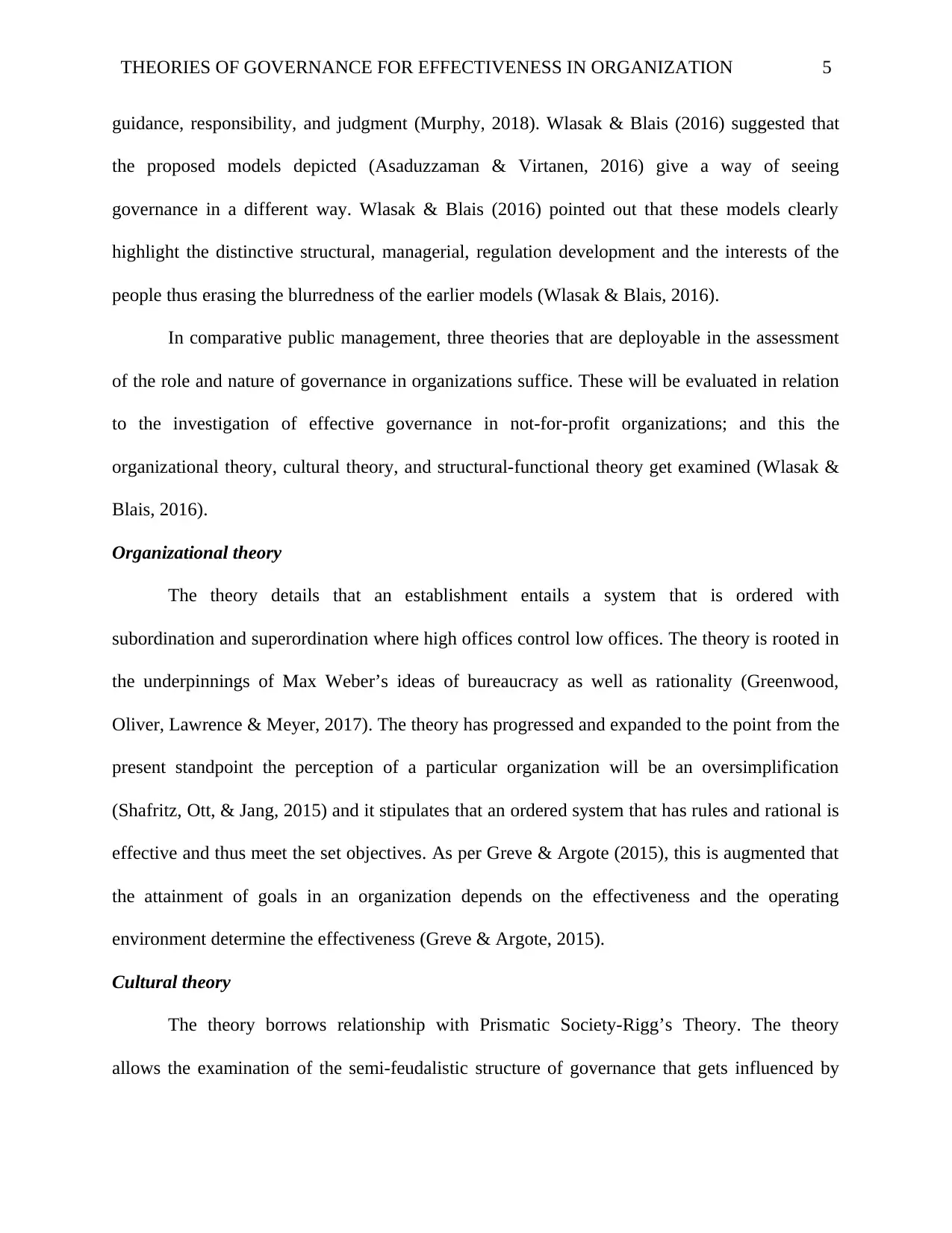
THEORIES OF GOVERNANCE FOR EFFECTIVENESS IN ORGANIZATION 5
guidance, responsibility, and judgment (Murphy, 2018). Wlasak & Blais (2016) suggested that
the proposed models depicted (Asaduzzaman & Virtanen, 2016) give a way of seeing
governance in a different way. Wlasak & Blais (2016) pointed out that these models clearly
highlight the distinctive structural, managerial, regulation development and the interests of the
people thus erasing the blurredness of the earlier models (Wlasak & Blais, 2016).
In comparative public management, three theories that are deployable in the assessment
of the role and nature of governance in organizations suffice. These will be evaluated in relation
to the investigation of effective governance in not-for-profit organizations; and this the
organizational theory, cultural theory, and structural-functional theory get examined (Wlasak &
Blais, 2016).
Organizational theory
The theory details that an establishment entails a system that is ordered with
subordination and superordination where high offices control low offices. The theory is rooted in
the underpinnings of Max Weber’s ideas of bureaucracy as well as rationality (Greenwood,
Oliver, Lawrence & Meyer, 2017). The theory has progressed and expanded to the point from the
present standpoint the perception of a particular organization will be an oversimplification
(Shafritz, Ott, & Jang, 2015) and it stipulates that an ordered system that has rules and rational is
effective and thus meet the set objectives. As per Greve & Argote (2015), this is augmented that
the attainment of goals in an organization depends on the effectiveness and the operating
environment determine the effectiveness (Greve & Argote, 2015).
Cultural theory
The theory borrows relationship with Prismatic Society-Rigg’s Theory. The theory
allows the examination of the semi-feudalistic structure of governance that gets influenced by
guidance, responsibility, and judgment (Murphy, 2018). Wlasak & Blais (2016) suggested that
the proposed models depicted (Asaduzzaman & Virtanen, 2016) give a way of seeing
governance in a different way. Wlasak & Blais (2016) pointed out that these models clearly
highlight the distinctive structural, managerial, regulation development and the interests of the
people thus erasing the blurredness of the earlier models (Wlasak & Blais, 2016).
In comparative public management, three theories that are deployable in the assessment
of the role and nature of governance in organizations suffice. These will be evaluated in relation
to the investigation of effective governance in not-for-profit organizations; and this the
organizational theory, cultural theory, and structural-functional theory get examined (Wlasak &
Blais, 2016).
Organizational theory
The theory details that an establishment entails a system that is ordered with
subordination and superordination where high offices control low offices. The theory is rooted in
the underpinnings of Max Weber’s ideas of bureaucracy as well as rationality (Greenwood,
Oliver, Lawrence & Meyer, 2017). The theory has progressed and expanded to the point from the
present standpoint the perception of a particular organization will be an oversimplification
(Shafritz, Ott, & Jang, 2015) and it stipulates that an ordered system that has rules and rational is
effective and thus meet the set objectives. As per Greve & Argote (2015), this is augmented that
the attainment of goals in an organization depends on the effectiveness and the operating
environment determine the effectiveness (Greve & Argote, 2015).
Cultural theory
The theory borrows relationship with Prismatic Society-Rigg’s Theory. The theory
allows the examination of the semi-feudalistic structure of governance that gets influenced by
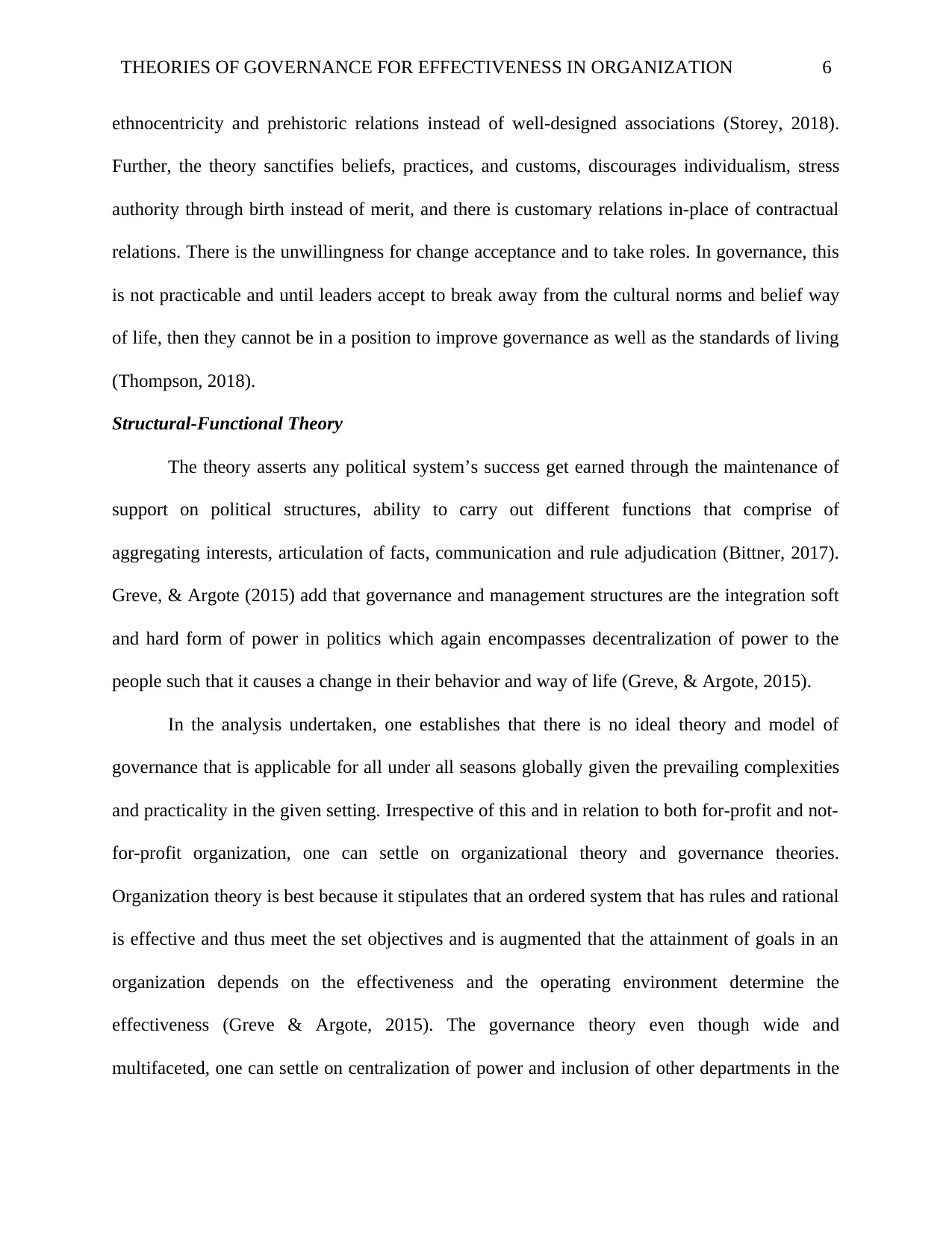
THEORIES OF GOVERNANCE FOR EFFECTIVENESS IN ORGANIZATION 6
ethnocentricity and prehistoric relations instead of well-designed associations (Storey, 2018).
Further, the theory sanctifies beliefs, practices, and customs, discourages individualism, stress
authority through birth instead of merit, and there is customary relations in-place of contractual
relations. There is the unwillingness for change acceptance and to take roles. In governance, this
is not practicable and until leaders accept to break away from the cultural norms and belief way
of life, then they cannot be in a position to improve governance as well as the standards of living
(Thompson, 2018).
Structural-Functional Theory
The theory asserts any political system’s success get earned through the maintenance of
support on political structures, ability to carry out different functions that comprise of
aggregating interests, articulation of facts, communication and rule adjudication (Bittner, 2017).
Greve, & Argote (2015) add that governance and management structures are the integration soft
and hard form of power in politics which again encompasses decentralization of power to the
people such that it causes a change in their behavior and way of life (Greve, & Argote, 2015).
In the analysis undertaken, one establishes that there is no ideal theory and model of
governance that is applicable for all under all seasons globally given the prevailing complexities
and practicality in the given setting. Irrespective of this and in relation to both for-profit and not-
for-profit organization, one can settle on organizational theory and governance theories.
Organization theory is best because it stipulates that an ordered system that has rules and rational
is effective and thus meet the set objectives and is augmented that the attainment of goals in an
organization depends on the effectiveness and the operating environment determine the
effectiveness (Greve & Argote, 2015). The governance theory even though wide and
multifaceted, one can settle on centralization of power and inclusion of other departments in the
ethnocentricity and prehistoric relations instead of well-designed associations (Storey, 2018).
Further, the theory sanctifies beliefs, practices, and customs, discourages individualism, stress
authority through birth instead of merit, and there is customary relations in-place of contractual
relations. There is the unwillingness for change acceptance and to take roles. In governance, this
is not practicable and until leaders accept to break away from the cultural norms and belief way
of life, then they cannot be in a position to improve governance as well as the standards of living
(Thompson, 2018).
Structural-Functional Theory
The theory asserts any political system’s success get earned through the maintenance of
support on political structures, ability to carry out different functions that comprise of
aggregating interests, articulation of facts, communication and rule adjudication (Bittner, 2017).
Greve, & Argote (2015) add that governance and management structures are the integration soft
and hard form of power in politics which again encompasses decentralization of power to the
people such that it causes a change in their behavior and way of life (Greve, & Argote, 2015).
In the analysis undertaken, one establishes that there is no ideal theory and model of
governance that is applicable for all under all seasons globally given the prevailing complexities
and practicality in the given setting. Irrespective of this and in relation to both for-profit and not-
for-profit organization, one can settle on organizational theory and governance theories.
Organization theory is best because it stipulates that an ordered system that has rules and rational
is effective and thus meet the set objectives and is augmented that the attainment of goals in an
organization depends on the effectiveness and the operating environment determine the
effectiveness (Greve & Argote, 2015). The governance theory even though wide and
multifaceted, one can settle on centralization of power and inclusion of other departments in the
⊘ This is a preview!⊘
Do you want full access?
Subscribe today to unlock all pages.

Trusted by 1+ million students worldwide
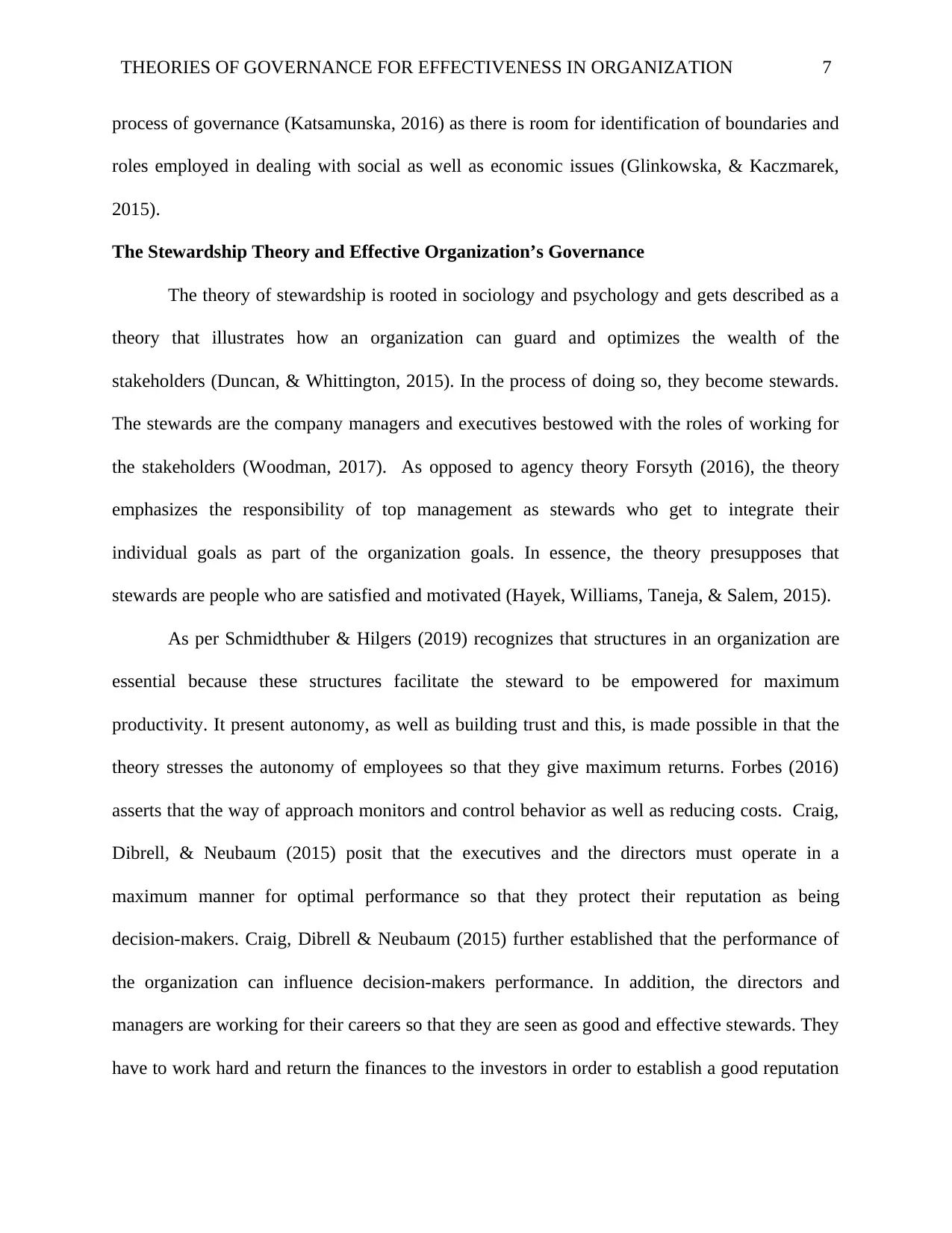
THEORIES OF GOVERNANCE FOR EFFECTIVENESS IN ORGANIZATION 7
process of governance (Katsamunska, 2016) as there is room for identification of boundaries and
roles employed in dealing with social as well as economic issues (Glinkowska, & Kaczmarek,
2015).
The Stewardship Theory and Effective Organization’s Governance
The theory of stewardship is rooted in sociology and psychology and gets described as a
theory that illustrates how an organization can guard and optimizes the wealth of the
stakeholders (Duncan, & Whittington, 2015). In the process of doing so, they become stewards.
The stewards are the company managers and executives bestowed with the roles of working for
the stakeholders (Woodman, 2017). As opposed to agency theory Forsyth (2016), the theory
emphasizes the responsibility of top management as stewards who get to integrate their
individual goals as part of the organization goals. In essence, the theory presupposes that
stewards are people who are satisfied and motivated (Hayek, Williams, Taneja, & Salem, 2015).
As per Schmidthuber & Hilgers (2019) recognizes that structures in an organization are
essential because these structures facilitate the steward to be empowered for maximum
productivity. It present autonomy, as well as building trust and this, is made possible in that the
theory stresses the autonomy of employees so that they give maximum returns. Forbes (2016)
asserts that the way of approach monitors and control behavior as well as reducing costs. Craig,
Dibrell, & Neubaum (2015) posit that the executives and the directors must operate in a
maximum manner for optimal performance so that they protect their reputation as being
decision-makers. Craig, Dibrell & Neubaum (2015) further established that the performance of
the organization can influence decision-makers performance. In addition, the directors and
managers are working for their careers so that they are seen as good and effective stewards. They
have to work hard and return the finances to the investors in order to establish a good reputation
process of governance (Katsamunska, 2016) as there is room for identification of boundaries and
roles employed in dealing with social as well as economic issues (Glinkowska, & Kaczmarek,
2015).
The Stewardship Theory and Effective Organization’s Governance
The theory of stewardship is rooted in sociology and psychology and gets described as a
theory that illustrates how an organization can guard and optimizes the wealth of the
stakeholders (Duncan, & Whittington, 2015). In the process of doing so, they become stewards.
The stewards are the company managers and executives bestowed with the roles of working for
the stakeholders (Woodman, 2017). As opposed to agency theory Forsyth (2016), the theory
emphasizes the responsibility of top management as stewards who get to integrate their
individual goals as part of the organization goals. In essence, the theory presupposes that
stewards are people who are satisfied and motivated (Hayek, Williams, Taneja, & Salem, 2015).
As per Schmidthuber & Hilgers (2019) recognizes that structures in an organization are
essential because these structures facilitate the steward to be empowered for maximum
productivity. It present autonomy, as well as building trust and this, is made possible in that the
theory stresses the autonomy of employees so that they give maximum returns. Forbes (2016)
asserts that the way of approach monitors and control behavior as well as reducing costs. Craig,
Dibrell, & Neubaum (2015) posit that the executives and the directors must operate in a
maximum manner for optimal performance so that they protect their reputation as being
decision-makers. Craig, Dibrell & Neubaum (2015) further established that the performance of
the organization can influence decision-makers performance. In addition, the directors and
managers are working for their careers so that they are seen as good and effective stewards. They
have to work hard and return the finances to the investors in order to establish a good reputation
Paraphrase This Document
Need a fresh take? Get an instant paraphrase of this document with our AI Paraphraser
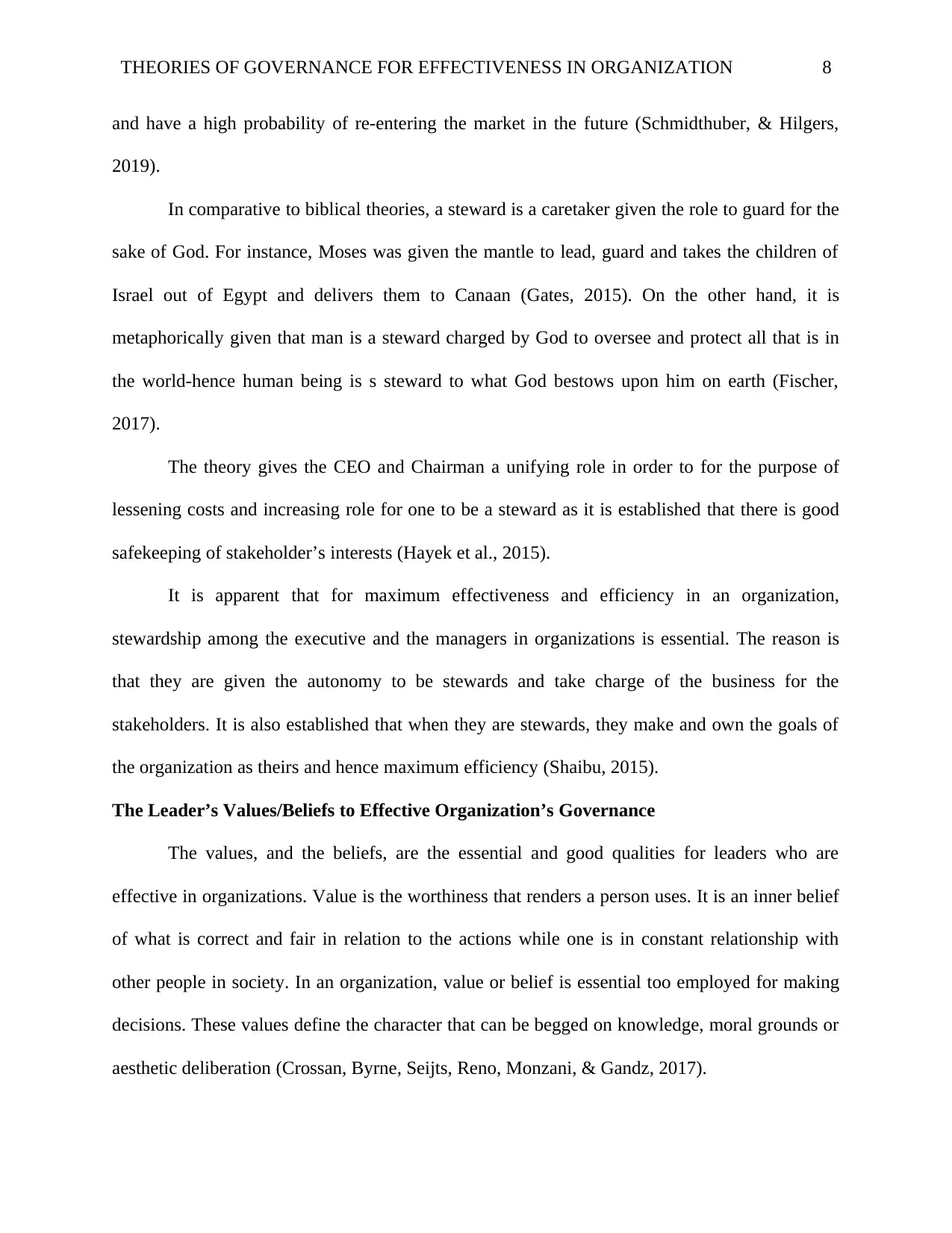
THEORIES OF GOVERNANCE FOR EFFECTIVENESS IN ORGANIZATION 8
and have a high probability of re-entering the market in the future (Schmidthuber, & Hilgers,
2019).
In comparative to biblical theories, a steward is a caretaker given the role to guard for the
sake of God. For instance, Moses was given the mantle to lead, guard and takes the children of
Israel out of Egypt and delivers them to Canaan (Gates, 2015). On the other hand, it is
metaphorically given that man is a steward charged by God to oversee and protect all that is in
the world-hence human being is s steward to what God bestows upon him on earth (Fischer,
2017).
The theory gives the CEO and Chairman a unifying role in order to for the purpose of
lessening costs and increasing role for one to be a steward as it is established that there is good
safekeeping of stakeholder’s interests (Hayek et al., 2015).
It is apparent that for maximum effectiveness and efficiency in an organization,
stewardship among the executive and the managers in organizations is essential. The reason is
that they are given the autonomy to be stewards and take charge of the business for the
stakeholders. It is also established that when they are stewards, they make and own the goals of
the organization as theirs and hence maximum efficiency (Shaibu, 2015).
The Leader’s Values/Beliefs to Effective Organization’s Governance
The values, and the beliefs, are the essential and good qualities for leaders who are
effective in organizations. Value is the worthiness that renders a person uses. It is an inner belief
of what is correct and fair in relation to the actions while one is in constant relationship with
other people in society. In an organization, value or belief is essential too employed for making
decisions. These values define the character that can be begged on knowledge, moral grounds or
aesthetic deliberation (Crossan, Byrne, Seijts, Reno, Monzani, & Gandz, 2017).
and have a high probability of re-entering the market in the future (Schmidthuber, & Hilgers,
2019).
In comparative to biblical theories, a steward is a caretaker given the role to guard for the
sake of God. For instance, Moses was given the mantle to lead, guard and takes the children of
Israel out of Egypt and delivers them to Canaan (Gates, 2015). On the other hand, it is
metaphorically given that man is a steward charged by God to oversee and protect all that is in
the world-hence human being is s steward to what God bestows upon him on earth (Fischer,
2017).
The theory gives the CEO and Chairman a unifying role in order to for the purpose of
lessening costs and increasing role for one to be a steward as it is established that there is good
safekeeping of stakeholder’s interests (Hayek et al., 2015).
It is apparent that for maximum effectiveness and efficiency in an organization,
stewardship among the executive and the managers in organizations is essential. The reason is
that they are given the autonomy to be stewards and take charge of the business for the
stakeholders. It is also established that when they are stewards, they make and own the goals of
the organization as theirs and hence maximum efficiency (Shaibu, 2015).
The Leader’s Values/Beliefs to Effective Organization’s Governance
The values, and the beliefs, are the essential and good qualities for leaders who are
effective in organizations. Value is the worthiness that renders a person uses. It is an inner belief
of what is correct and fair in relation to the actions while one is in constant relationship with
other people in society. In an organization, value or belief is essential too employed for making
decisions. These values define the character that can be begged on knowledge, moral grounds or
aesthetic deliberation (Crossan, Byrne, Seijts, Reno, Monzani, & Gandz, 2017).
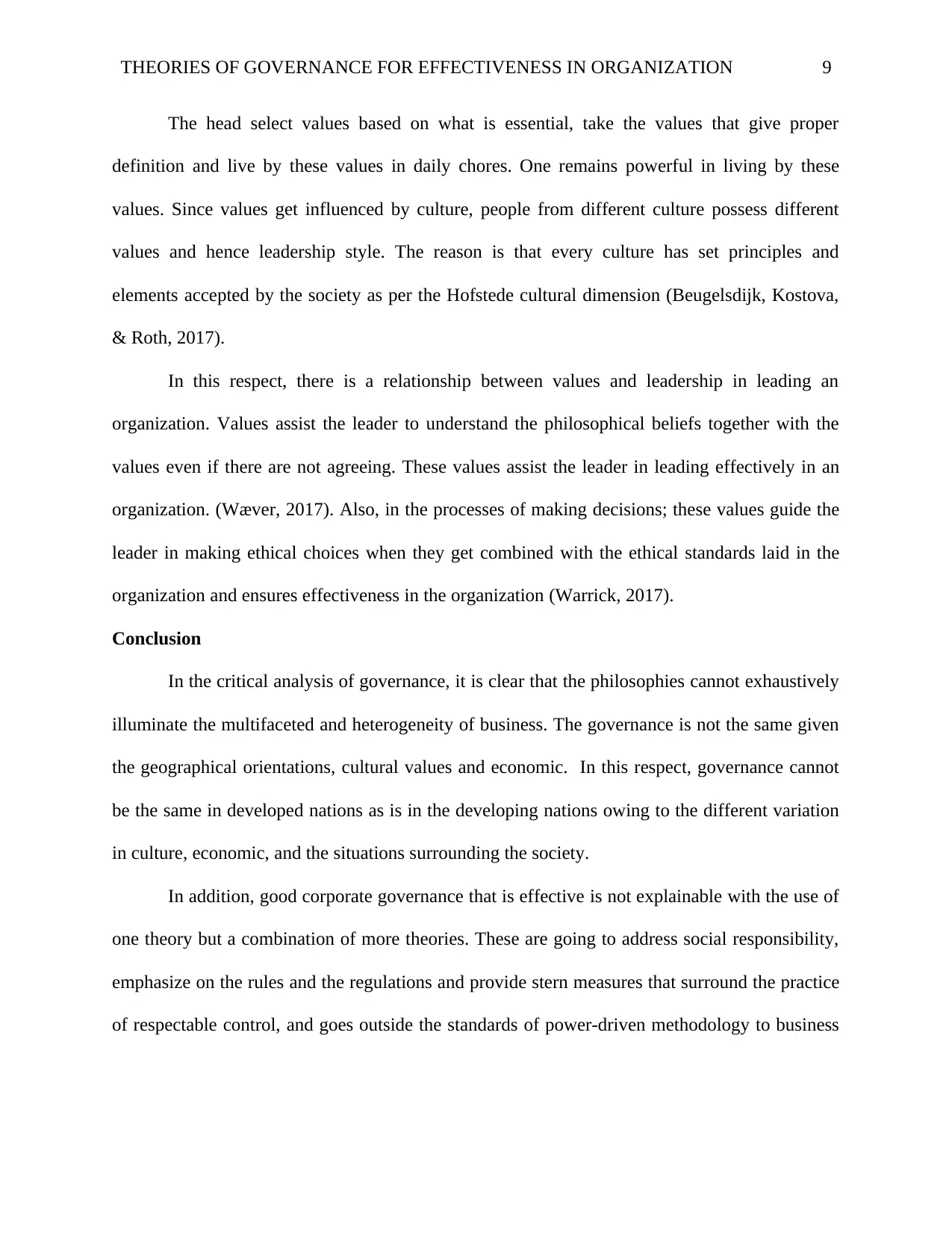
THEORIES OF GOVERNANCE FOR EFFECTIVENESS IN ORGANIZATION 9
The head select values based on what is essential, take the values that give proper
definition and live by these values in daily chores. One remains powerful in living by these
values. Since values get influenced by culture, people from different culture possess different
values and hence leadership style. The reason is that every culture has set principles and
elements accepted by the society as per the Hofstede cultural dimension (Beugelsdijk, Kostova,
& Roth, 2017).
In this respect, there is a relationship between values and leadership in leading an
organization. Values assist the leader to understand the philosophical beliefs together with the
values even if there are not agreeing. These values assist the leader in leading effectively in an
organization. (Wæver, 2017). Also, in the processes of making decisions; these values guide the
leader in making ethical choices when they get combined with the ethical standards laid in the
organization and ensures effectiveness in the organization (Warrick, 2017).
Conclusion
In the critical analysis of governance, it is clear that the philosophies cannot exhaustively
illuminate the multifaceted and heterogeneity of business. The governance is not the same given
the geographical orientations, cultural values and economic. In this respect, governance cannot
be the same in developed nations as is in the developing nations owing to the different variation
in culture, economic, and the situations surrounding the society.
In addition, good corporate governance that is effective is not explainable with the use of
one theory but a combination of more theories. These are going to address social responsibility,
emphasize on the rules and the regulations and provide stern measures that surround the practice
of respectable control, and goes outside the standards of power-driven methodology to business
The head select values based on what is essential, take the values that give proper
definition and live by these values in daily chores. One remains powerful in living by these
values. Since values get influenced by culture, people from different culture possess different
values and hence leadership style. The reason is that every culture has set principles and
elements accepted by the society as per the Hofstede cultural dimension (Beugelsdijk, Kostova,
& Roth, 2017).
In this respect, there is a relationship between values and leadership in leading an
organization. Values assist the leader to understand the philosophical beliefs together with the
values even if there are not agreeing. These values assist the leader in leading effectively in an
organization. (Wæver, 2017). Also, in the processes of making decisions; these values guide the
leader in making ethical choices when they get combined with the ethical standards laid in the
organization and ensures effectiveness in the organization (Warrick, 2017).
Conclusion
In the critical analysis of governance, it is clear that the philosophies cannot exhaustively
illuminate the multifaceted and heterogeneity of business. The governance is not the same given
the geographical orientations, cultural values and economic. In this respect, governance cannot
be the same in developed nations as is in the developing nations owing to the different variation
in culture, economic, and the situations surrounding the society.
In addition, good corporate governance that is effective is not explainable with the use of
one theory but a combination of more theories. These are going to address social responsibility,
emphasize on the rules and the regulations and provide stern measures that surround the practice
of respectable control, and goes outside the standards of power-driven methodology to business
⊘ This is a preview!⊘
Do you want full access?
Subscribe today to unlock all pages.

Trusted by 1+ million students worldwide
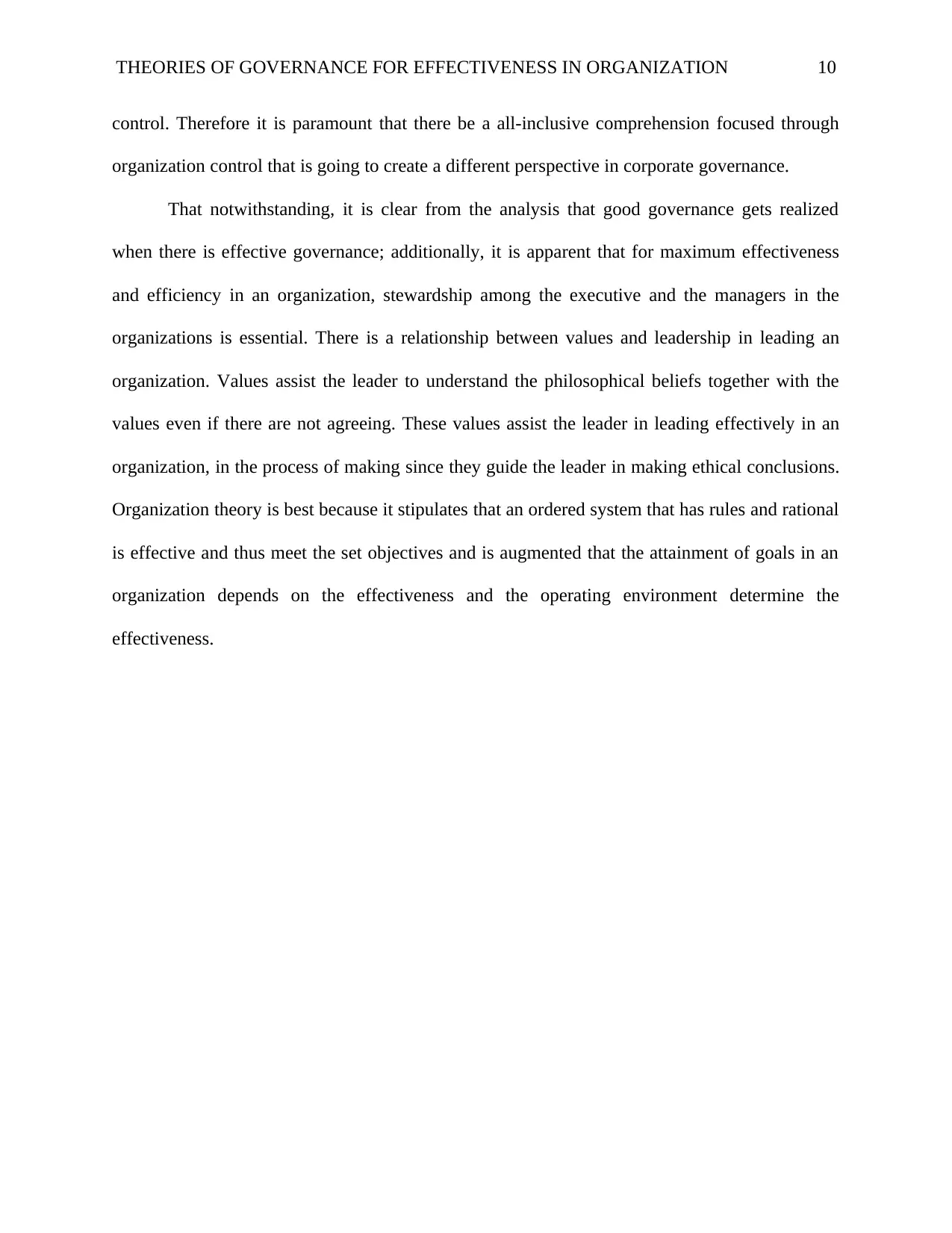
THEORIES OF GOVERNANCE FOR EFFECTIVENESS IN ORGANIZATION 10
control. Therefore it is paramount that there be a all-inclusive comprehension focused through
organization control that is going to create a different perspective in corporate governance.
That notwithstanding, it is clear from the analysis that good governance gets realized
when there is effective governance; additionally, it is apparent that for maximum effectiveness
and efficiency in an organization, stewardship among the executive and the managers in the
organizations is essential. There is a relationship between values and leadership in leading an
organization. Values assist the leader to understand the philosophical beliefs together with the
values even if there are not agreeing. These values assist the leader in leading effectively in an
organization, in the process of making since they guide the leader in making ethical conclusions.
Organization theory is best because it stipulates that an ordered system that has rules and rational
is effective and thus meet the set objectives and is augmented that the attainment of goals in an
organization depends on the effectiveness and the operating environment determine the
effectiveness.
control. Therefore it is paramount that there be a all-inclusive comprehension focused through
organization control that is going to create a different perspective in corporate governance.
That notwithstanding, it is clear from the analysis that good governance gets realized
when there is effective governance; additionally, it is apparent that for maximum effectiveness
and efficiency in an organization, stewardship among the executive and the managers in the
organizations is essential. There is a relationship between values and leadership in leading an
organization. Values assist the leader to understand the philosophical beliefs together with the
values even if there are not agreeing. These values assist the leader in leading effectively in an
organization, in the process of making since they guide the leader in making ethical conclusions.
Organization theory is best because it stipulates that an ordered system that has rules and rational
is effective and thus meet the set objectives and is augmented that the attainment of goals in an
organization depends on the effectiveness and the operating environment determine the
effectiveness.
Paraphrase This Document
Need a fresh take? Get an instant paraphrase of this document with our AI Paraphraser
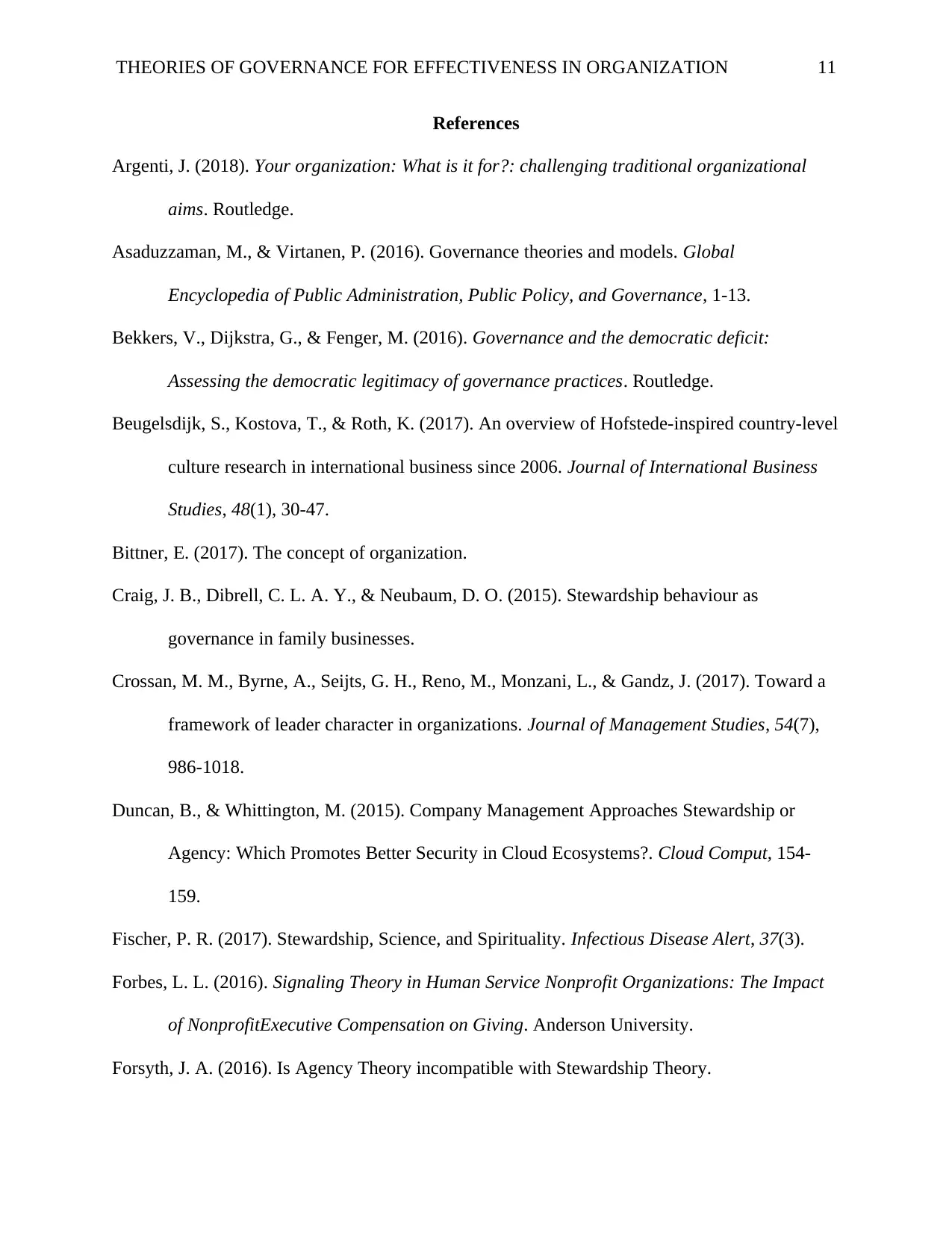
THEORIES OF GOVERNANCE FOR EFFECTIVENESS IN ORGANIZATION 11
References
Argenti, J. (2018). Your organization: What is it for?: challenging traditional organizational
aims. Routledge.
Asaduzzaman, M., & Virtanen, P. (2016). Governance theories and models. Global
Encyclopedia of Public Administration, Public Policy, and Governance, 1-13.
Bekkers, V., Dijkstra, G., & Fenger, M. (2016). Governance and the democratic deficit:
Assessing the democratic legitimacy of governance practices. Routledge.
Beugelsdijk, S., Kostova, T., & Roth, K. (2017). An overview of Hofstede-inspired country-level
culture research in international business since 2006. Journal of International Business
Studies, 48(1), 30-47.
Bittner, E. (2017). The concept of organization.
Craig, J. B., Dibrell, C. L. A. Y., & Neubaum, D. O. (2015). Stewardship behaviour as
governance in family businesses.
Crossan, M. M., Byrne, A., Seijts, G. H., Reno, M., Monzani, L., & Gandz, J. (2017). Toward a
framework of leader character in organizations. Journal of Management Studies, 54(7),
986-1018.
Duncan, B., & Whittington, M. (2015). Company Management Approaches Stewardship or
Agency: Which Promotes Better Security in Cloud Ecosystems?. Cloud Comput, 154-
159.
Fischer, P. R. (2017). Stewardship, Science, and Spirituality. Infectious Disease Alert, 37(3).
Forbes, L. L. (2016). Signaling Theory in Human Service Nonprofit Organizations: The Impact
of NonprofitExecutive Compensation on Giving. Anderson University.
Forsyth, J. A. (2016). Is Agency Theory incompatible with Stewardship Theory.
References
Argenti, J. (2018). Your organization: What is it for?: challenging traditional organizational
aims. Routledge.
Asaduzzaman, M., & Virtanen, P. (2016). Governance theories and models. Global
Encyclopedia of Public Administration, Public Policy, and Governance, 1-13.
Bekkers, V., Dijkstra, G., & Fenger, M. (2016). Governance and the democratic deficit:
Assessing the democratic legitimacy of governance practices. Routledge.
Beugelsdijk, S., Kostova, T., & Roth, K. (2017). An overview of Hofstede-inspired country-level
culture research in international business since 2006. Journal of International Business
Studies, 48(1), 30-47.
Bittner, E. (2017). The concept of organization.
Craig, J. B., Dibrell, C. L. A. Y., & Neubaum, D. O. (2015). Stewardship behaviour as
governance in family businesses.
Crossan, M. M., Byrne, A., Seijts, G. H., Reno, M., Monzani, L., & Gandz, J. (2017). Toward a
framework of leader character in organizations. Journal of Management Studies, 54(7),
986-1018.
Duncan, B., & Whittington, M. (2015). Company Management Approaches Stewardship or
Agency: Which Promotes Better Security in Cloud Ecosystems?. Cloud Comput, 154-
159.
Fischer, P. R. (2017). Stewardship, Science, and Spirituality. Infectious Disease Alert, 37(3).
Forbes, L. L. (2016). Signaling Theory in Human Service Nonprofit Organizations: The Impact
of NonprofitExecutive Compensation on Giving. Anderson University.
Forsyth, J. A. (2016). Is Agency Theory incompatible with Stewardship Theory.
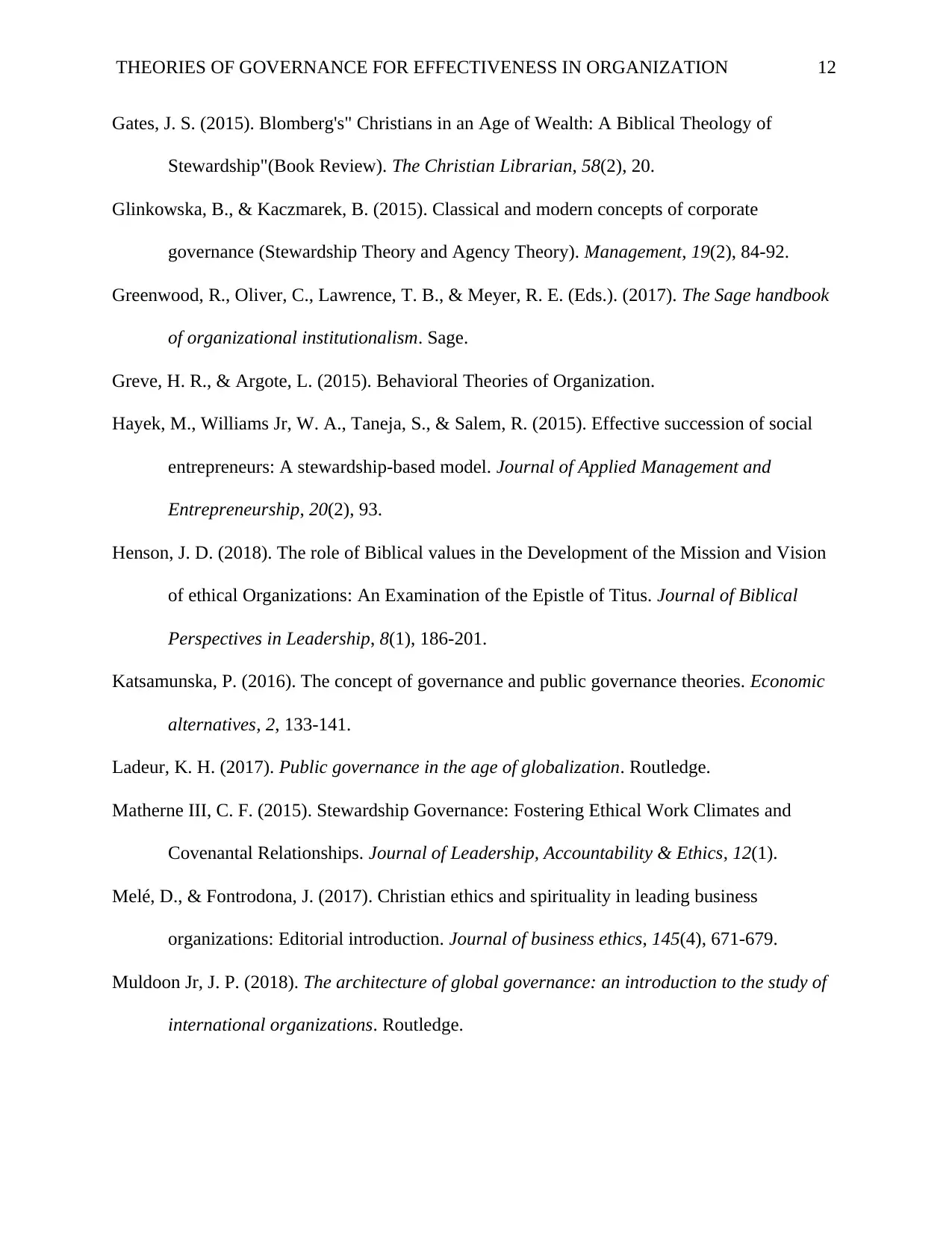
THEORIES OF GOVERNANCE FOR EFFECTIVENESS IN ORGANIZATION 12
Gates, J. S. (2015). Blomberg's" Christians in an Age of Wealth: A Biblical Theology of
Stewardship"(Book Review). The Christian Librarian, 58(2), 20.
Glinkowska, B., & Kaczmarek, B. (2015). Classical and modern concepts of corporate
governance (Stewardship Theory and Agency Theory). Management, 19(2), 84-92.
Greenwood, R., Oliver, C., Lawrence, T. B., & Meyer, R. E. (Eds.). (2017). The Sage handbook
of organizational institutionalism. Sage.
Greve, H. R., & Argote, L. (2015). Behavioral Theories of Organization.
Hayek, M., Williams Jr, W. A., Taneja, S., & Salem, R. (2015). Effective succession of social
entrepreneurs: A stewardship-based model. Journal of Applied Management and
Entrepreneurship, 20(2), 93.
Henson, J. D. (2018). The role of Biblical values in the Development of the Mission and Vision
of ethical Organizations: An Examination of the Epistle of Titus. Journal of Biblical
Perspectives in Leadership, 8(1), 186-201.
Katsamunska, P. (2016). The concept of governance and public governance theories. Economic
alternatives, 2, 133-141.
Ladeur, K. H. (2017). Public governance in the age of globalization. Routledge.
Matherne III, C. F. (2015). Stewardship Governance: Fostering Ethical Work Climates and
Covenantal Relationships. Journal of Leadership, Accountability & Ethics, 12(1).
Melé, D., & Fontrodona, J. (2017). Christian ethics and spirituality in leading business
organizations: Editorial introduction. Journal of business ethics, 145(4), 671-679.
Muldoon Jr, J. P. (2018). The architecture of global governance: an introduction to the study of
international organizations. Routledge.
Gates, J. S. (2015). Blomberg's" Christians in an Age of Wealth: A Biblical Theology of
Stewardship"(Book Review). The Christian Librarian, 58(2), 20.
Glinkowska, B., & Kaczmarek, B. (2015). Classical and modern concepts of corporate
governance (Stewardship Theory and Agency Theory). Management, 19(2), 84-92.
Greenwood, R., Oliver, C., Lawrence, T. B., & Meyer, R. E. (Eds.). (2017). The Sage handbook
of organizational institutionalism. Sage.
Greve, H. R., & Argote, L. (2015). Behavioral Theories of Organization.
Hayek, M., Williams Jr, W. A., Taneja, S., & Salem, R. (2015). Effective succession of social
entrepreneurs: A stewardship-based model. Journal of Applied Management and
Entrepreneurship, 20(2), 93.
Henson, J. D. (2018). The role of Biblical values in the Development of the Mission and Vision
of ethical Organizations: An Examination of the Epistle of Titus. Journal of Biblical
Perspectives in Leadership, 8(1), 186-201.
Katsamunska, P. (2016). The concept of governance and public governance theories. Economic
alternatives, 2, 133-141.
Ladeur, K. H. (2017). Public governance in the age of globalization. Routledge.
Matherne III, C. F. (2015). Stewardship Governance: Fostering Ethical Work Climates and
Covenantal Relationships. Journal of Leadership, Accountability & Ethics, 12(1).
Melé, D., & Fontrodona, J. (2017). Christian ethics and spirituality in leading business
organizations: Editorial introduction. Journal of business ethics, 145(4), 671-679.
Muldoon Jr, J. P. (2018). The architecture of global governance: an introduction to the study of
international organizations. Routledge.
⊘ This is a preview!⊘
Do you want full access?
Subscribe today to unlock all pages.

Trusted by 1+ million students worldwide
1 out of 13
Related Documents
Your All-in-One AI-Powered Toolkit for Academic Success.
+13062052269
info@desklib.com
Available 24*7 on WhatsApp / Email
![[object Object]](/_next/static/media/star-bottom.7253800d.svg)
Unlock your academic potential
Copyright © 2020–2025 A2Z Services. All Rights Reserved. Developed and managed by ZUCOL.





